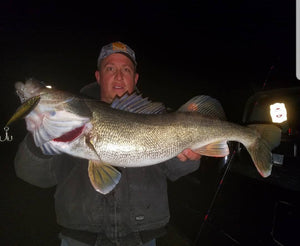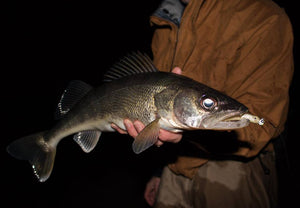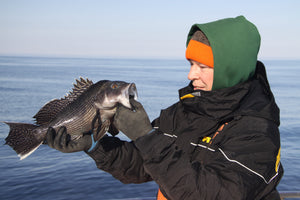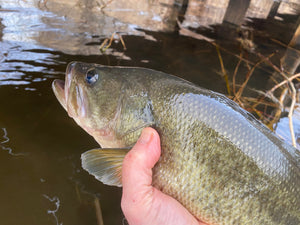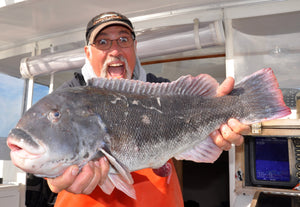Go Light for Sweeter Spring Bite

Yellow perch often favor light-tackle presentations. Target them in open water. OutdoorTom.com photo.
You’ve got to love the spring season here on Long Island if you are a freshwater fan. As April rolls into May and the water continues to warm, the action increases exponentially. At this point trout are still in play in the more open pockets, bluegill, pumpkinseed, perch and crappies should be pushing up against the shore, and bass and pickerel can be found patrolling weed edges in relatively shallow water.
If you are a light-tackle fan – or would like to be – now is your time to shine. For the next several weeks you can expect to still find a few inches to a foot or more between the weeds and the surface on many waters. This allows use of a variety of lightweight lures that will become much harder to work once the bloom spreads across the surface and forces most anglers to switch to heavier gear and slop-fishing tactics. The term “light-tackle” is, of course, a relative description where fishing gear is concerned. For our purposes, let's consider it to be spinning setups in the four- to six-pound-class. These are light enough to really make a difference when working smaller lures in relatively open water, yet still powerful enough to handle an occasional lunker.
Going light allows anglers to feel the full fury of smaller battlers, making a big bluegill, crappie, yellow perch or mid-sized bigmouth feel like a monster at the end of the line. Experience even just a little bit of success with this gear and you'll quickly find it becomes a major part of your freshwater fishing arsenal not only in the spring but throughout the year. In terms of tackle choice for this endeavor, you’ll want to focus on spinning gear, starting with the rod. A good starting point is to stop by the shop and out our St. Croix Premier or Triumph series. A 6-foot 6-inch medium-light or light model rod that can handle up to 5/16- or ½-ounce lures, respectively, is ideal for use with four- to eight-pound-test mono lines or 10-pound-test braid. Both of these rods are super-sensitive and surprisingly strong for their class. Match either to a size 1000 Daiwa Feugo LT, Penn Battle III, Daiwa Ballistic MQ LT or Shimano Stradic spinning reel, and we’re talking one sweet setup that’s perfectly matched to the spring and early summer bite but can see action all year long.
 A lightweight spinning outfit and a little bit of open water is a great combination for spring action on almost any Long Island pond. OutdoorTom.com photo.
A lightweight spinning outfit and a little bit of open water is a great combination for spring action on almost any Long Island pond. OutdoorTom.com photo.
With the ability to present small lures, hooking-up is actually one of the least problems for light-tackle enthusiasts. The real challenge is landing your quarry after the strike. For this it helps to have a properly set drag and enough patience to allow a substantial fish to reasonably tire itself out before trying to guide it into a net or lift it from the water. One mistake anglers frequently make in this regard is setting the drag too loose. The natural instinct is to back down the drag setting substantially in a hedge against break-offs. Unfortunately, this approach can allow your quarry to steam off toward the nearest snag. Even with ultralight gear, it’s important to have enough strength to turn a fish from heavy cover - so set your drag at about one-third the breaking strength of the line and use the flexibility of your rod tip rather than the reel to dampen sharp lunges and powerful runs.
Be aware, too, that raising your rod tip straight up will increase pressure on a strong fish while pointing the tip at the fish allows drag to peel more easily from your reel. Thus, you can vary the amount of drag simply by altering your rod angle to make it harder or easier for a fish to take line.
Nearly as important as how you handle your quarry on light line is choosing where the battle begins. As a rule, light tackle is best suited for use in shallow open water like the mouth of a cove, sandbar edge or the slope of a shallow point. Rather than cast into thick mats and heavy cover as you might with studier gear, work lures parallel to weed edges and four to six feet away from blow downs and stick-ups. The idea is to draw the fish out from the snags so that they strike in more open water. Cove mouths, by the way, are especially productive light-tackle areas as they generally feature open water stretches yet still serve as pinch points for roaming fish.
 Small, unweighted creature baits can generate a lot of action when fished on ultralight tackle. OutdoorTom.com photo.
Small, unweighted creature baits can generate a lot of action when fished on ultralight tackle. OutdoorTom.com photo.
You'll find a wide variety of lightweight lures actually work better with ultralight gear than they do with standard fishing tackle. A 2-3/4- to 4-3/8-inch Rapala Original Floating Minnow can catch just about anything that swims in our shallow freshwater environments. To dig a little deeper, try a 2-1/2-inch to 2-3/4-inch Shad Rap. Rapala’s Skitter Pop in the 2-inch size draws plenty of surface strikes from fish of all sizes. For adding more flash and commotion to your retrieve, a brightly colored Strike King Mini-King or Micro King spinnerbait fits the bill, as does Panther Martin’s Sonic Streamer in the ¼- and 3/8-ounce size. Both are deadly for big crappies, mid-sized largemouths, and pickerel of all sizes. At the opposite end of the spectrum, 6-inch Berkley Gulp nightcrawler rigged weightless and weedless offers a way to work some finesse into your retrieve. With this lure, you might even try getting a little closer to the weeds, stick-ups and dock pilings.
- Bryce Poyer

